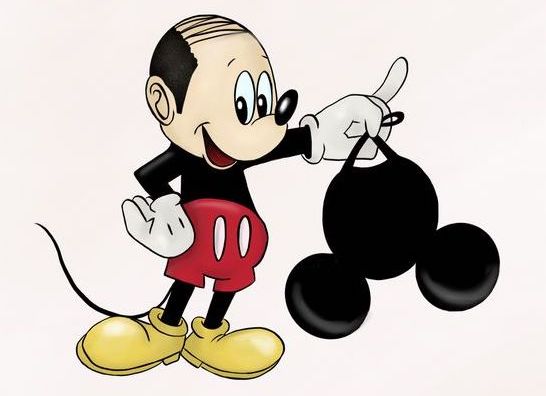Hair Like Mickey Mouse – Get the Details

It is no exaggeration to say that Mickey Mouse is one of the most beloved cartoon characters of all time. From his appearances in cartoons and TV shows to his starring role at the Disney theme parks, it is safe to say that people of all ages love Mickey Mouse.
Except for the people with a hairstyle that is starting to resemble the top of Mickey’s head.
Let’s take a look at how the hairline can start to resemble Mickey Mouse (yes, it is a real thing) and what can be done to improve the hairline of the person experiencing hair loss.
Mickey Mouse Hairline – What is it?
The hairline resemblance to Walt Disney’s most famous creation, which is known as the “Mickey Mouse Hair Effect,” did not gain that name simply because people thought it was a funny idea. The name describes a hereditary balding condition that starts by impacting both sides of the frontal hairline. The area of balding on the scalp will start to progress in an upward manner and it results in a look to the scalp that is similar to the head of Mickey Mouse.
While Mickey Mouse is meant to be funny and laughed at by the public, the people who experience balding do not find the look that it gives to the scalp something they find amusing.
The image suggests that Mickey is secretly bald, and he hides this from the public under mouse ears that are detachable. Once the mouse ears are removed, Mickey is revealed to have thinning hair that he styles in a way that is easy to hide under his mouse ears.
While there are some people who accept the image as the joke it is intended to be, there are others who think this is true as well as some people who get angry at the suggestion that their favorite mouse is going bald.
No matter what a balding person thinks about the image, once they start to have a hairline that looks like Mickey Mouse, what is the next step they can take to address the hair loss on their scalp?
(Not So) Spoiler Alert – They can inquire about undergoing a hair transplant!
Hair Transplant – What is Involved in the Process?
A hair transplant is when a surgeon moves hair follicles from the donor area of the scalp (usually the back and sides of the scalp) to the areas of the scalp where hair loss is occurring. If there is not enough high-quality donor hair available in the donor area of the scalp, the surgeon can use hair grafts from other areas of the body such as the beard, torso, and extremities.
These hair grafts are harvested by the surgeon and transplanted in naturally occurring groupings (of follicular units) to provide the baling area with hair that is natural in appearance.
The most popular method of harvesting hair from the donor area is through Follicular Unit Extraction (FUE). During an FUE procedure, the surgeon will individually harvest the hair grafts using microscopic techniques. Thanks to the individual removal of the hair grafts, there is no need for the surgeon to create a linear incision on the scalp (which means there is not a linear scar after the procedure). The surgeon will create tiny incisions in the targeted balding area so the follicular units can be transplanted into the scalp. The follicular units are also distributed in the scalp in such a way that the appearance of the hair will be natural in appearance and undetectable to the average eye.
The transplanted hair follicles will become part of the scalp within a few days of them being transplanted and implanted by the surgeon. Once the hair grafts are implanted into the scalp, the appearance of stubble will occur as well as the appearance of some scabbing in the transplanted area. (FYI: This scabbing will start to fall out on its own after a few weeks because the hair will enter the resting phase of the hair growth process.)
Several months after the hair grafts enter the resting phase, they will enter the growth phase and start to grow until they eventually become normal, mature hair. The transplanted hair will be resistant to the balding process even though it is placed in the (formerly) balding area of the scalp.
The hair that grows after a hair transplant is permanent and this means a person who had a head that resembled the scalp of Mickey Mouse will not look like the mouse anymore. In other words, the patient will be able to enjoy watching Mickey Mouse on TV without having to worry about having an appearance like the mouse.